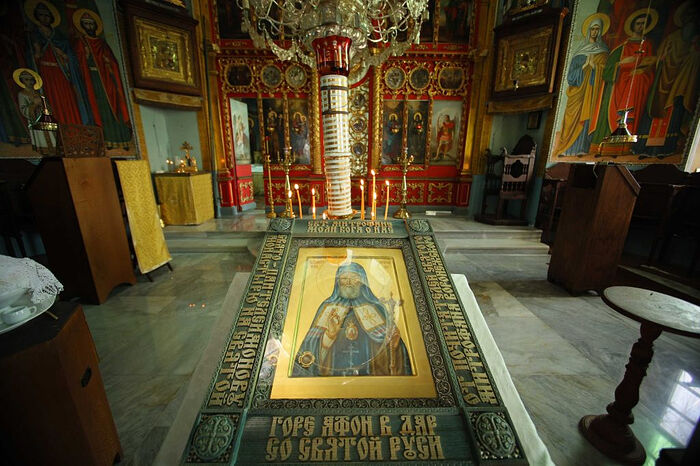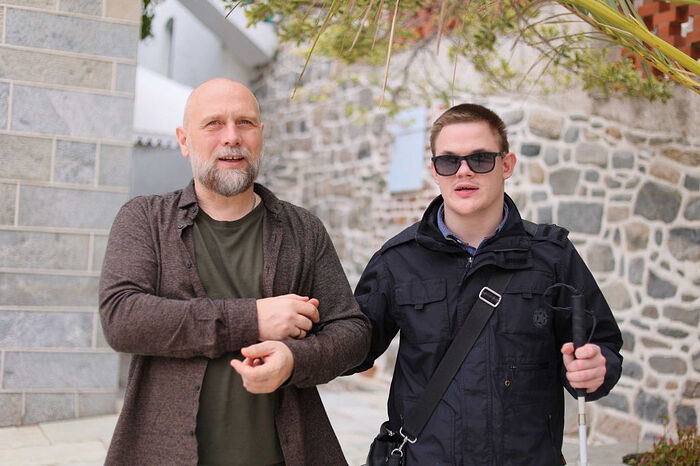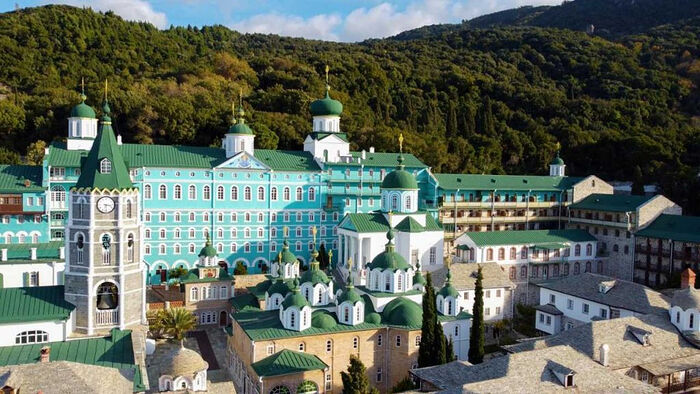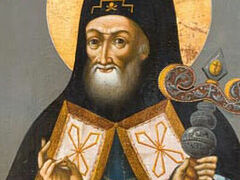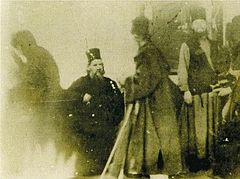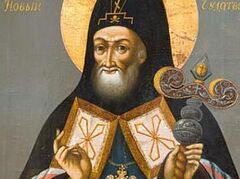On November 9, 2021, with the blessing of Bishop Hilarion (Kaigorodtsev) of Kineshma and Palekh, who especially venerates St. Mitrophan of Voronezh, a hand-painted icon of St. Mitrophan with a particle of his holy relics was delivered to St. Panteleimon’s, the Russian monastery on Holy Mount Athos. On the carved frame, there is the inscription: “To Holy Mt. Athos, from Holy Rus’.”
“For me as a bishop, this is a great event. St. Mitrophan is known to the Orthodox world as a patron of children and statesmen. But he’s also a patron of Athonite brothers and all monasticism. He’s a very dear saint to me. He’s my friend. He was an honest, courageous bishop. I talk to him as a patron and helper,” says Vladyka Hilarion.
The wondrous icon of the saint arrived to Greece from the saint’s homeland—from the Russian Ivanovo hinterlands. It was painted by the iconographer Evgenia Baikova. Zhenya has been painting icons of this Voronezh ascetic for several years now.
“Every time, the Holy Hierarch reveals something new to me. I feel his spiritual power and his speedy help.”
The future bishop Mitrophan was born on November 6, 1623, in the village of Antilokhovo, and became the simple village priest Mikhail. After the death of his wife, he took monastic vows in the Holy Dormition-Zolotnikovskaya Hermitage with the name Mitrophan. Later he was appointed abbot of the Holy Dormition-Kosmin Yakhroma Monastery, and later—of the St. Makary-Holy Dormition Monastery.
Having learned of the virtues of the wise pastor, the Council of Bishops, headed by Patriarch Joachim, consecrated Abbot Mitrophan as the bishop of the new Voronezh Diocese, and he was appointed to manage several monasteries outside of Moscow, in the vast Voronezh lands, at the same time.
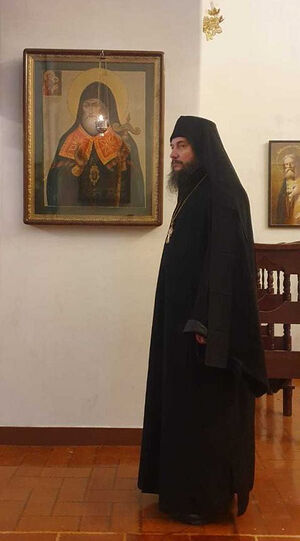 Abbot Lazar (Elistratov) of Holy Dormition-Zolotnikovskaya Monastery, who has been studying the life of the Holy Hierarch for many years, discovers something new and interesting about the glorious ascetic every time:
Abbot Lazar (Elistratov) of Holy Dormition-Zolotnikovskaya Monastery, who has been studying the life of the Holy Hierarch for many years, discovers something new and interesting about the glorious ascetic every time:
“Before the revolution, St. Mitrophan was known as the Russian Nicholas the Wonderworker. They were always painted together in churches and on icons. St. Mitrophan was accessible to everyone and he helped the poor and visited the sick and imprisoned. His episcopal residence was a shelter for the destitute and downtrodden. He would bury workers who had died in a foreign land at his own expense, and ceaselessly prayed for those who died without repentance and without having communed.
Tsar Peter I himself had great respect for this ascetic of faith. Accustomed to everything being submitted to his mighty will, Peter saw in St. Mitrophan a true spiritual pastor and father. The words with which the Holy Hierarch blessed Peter for future victories and for the foundation of St. Petersburg and the construction of the Kazan Cathedral there proved to be prophetic:
Take the Kazan Icon of the Mother of God, and she will help you defeat an evil and powerful enemy. Then you’ll take this icon to the new capital, a great city in honor of St. Peter. As long as this holy icon of the Most Pure Virgin is on the banks of the Neva, the grace of God and the protection of the Theotokos will not depart from the capital.
Few people know now that the city on the Neva appeared thanks to Bishop Mitrophan of Voronezh.
130 years after the foundation of St. Petersburg, the name of St. Mitrophan of Voronezh was honored on the Halkidiki Peninsula. This happened thanks to Hieromonk Anikita (Prince Sergei Shirinsky-Shikhmatov in the world). In 1835, he took an icon of St. Mitrophan to Mt. Athos. A church was later built in honor of the Holy Hierarch at Fr. Anikita’s initiative and expense.
The second St. Mitrophan Church was erected later, after Hieromonk Anikita had already reposed, at St. Panteleimon’s Monastery.
Nearly two centuries later, this fall, an icon of St. Mitrophan with a particle of his relics again arrived on Mt. Athos. With the blessing of Abbot Evlogy, the icon was placed on the central analogion stand of the ancient St. Mitrophan Church. Together with the dean of St. Panteleimon’s, and with the participation of many pilgrims, a Moleben of Thanksgiving with an Akathist to St. Mitrophan was served.
“Bishop Mitrophan doesn’t fit into the matrix of general Church codes and rules,” says Vladyka Hilarion. “He was a rock, a powerful administrator, and at the same time a meek, humble, loving pastor, living on the verge of poverty. I have a special friendship with the Holy Hierarch. I talk to him; I ask him to help me on my path in life. He’s a hierarch, and I’m a hierarch. I speak with him simply. I worry about the diocese, about our clergy. Times are hard now, but the Holy Hierarch strengthens me. He’s a beacon.”
The blind Vlad Shakin, who also accompanied the icon, is overcome with emotion:
“This is my third time on Mt. Athos. I came from Sergiev Posad. My spiritual father suggested that I go with some other pilgrims. I want with all my heart for the name of St. Mitrophan to be known and remembered. He’s a very strong advocate for us before God. It’s a shame he’s been forgotten to some degree. They say: We know St. Nicholas the Wonderworker, St. Matrona of Moscow, St. Sergius of Radonezh, but we don’t know this St. Mitrophan. We try to tell everyone about the Holy Hierarch, so the faithful couldn’t say this anymore. We’ve brought many gifts for the Athonite monks and 700 icons of Bishop Mitrophan to distribute to pilgrims from other cities and countries. And despite the November weather, I swam in the Aegean Sea. This is also a miracle.”
In difficult times for Mt. Athos, the illustrious bishop appeared to the Russian monks, urging them not to leave their monasteries and to more fervently pray on their spiritual frontiers, and the Greeks he called to brotherly love and unity in Christ. During the Russo-Turkish War, the icon of St. Mitrophan of Voronezh with his relics disappeared without a trace. Historical justice has been restored only now. The icon brought to Mt. Athos was accompanied by venerators of St. Mitrophan from seven cities of Russia: Moscow, St. Petersburg, Murmansk, Sergiev Posad, Kineshma, and Vladimir.
“We’re all proud and spoiled, and it’s hard for the saints to be with us,” laments Bishop Hilarion. “Look how the Lord takes away the elders—because people have no need of them now. As Fr. John (Krestiankin) once said: ‘Those elders you’re looking for—there are none now, because there is no one willing to be obedient—only debaters.’ People often look for elders to hear or get what they want. Then they again plunge into vanity, forgetting about God. And so the Lord admonishes and saves man with sorrows, illnesses, and difficulties. And if the Holy Hierarch happens to be here? Will the world receive him or not? We ask one thing—that God might forgive us all by the prayers of St. Mitrophan.”
The main purpose of the trip was to bring the forgotten name of the great saint of the Russian and Athonite land back from the darkness of oblivion, and to refresh the memory of our contemporaries about the life and exploits of St. Mitrophan. It’s especially important now, when the Sword of Damocles hangs over the world with endless lockdowns and restrictions both in the world and in the Church. There is coming a time of intense prayer and of holding one’s spiritual boundaries. This is the best time to ask for help and to be inspired by the example of our holy God-pleasers. Wonderous is God in His saints!
O our holy father Mitrophan, pray to God for us!

